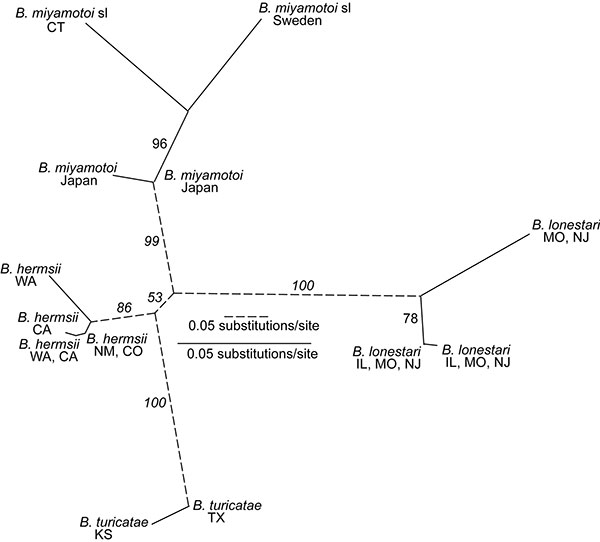Volume 10, Number 9—September 2004
Dispatch
Typing of Borrelia Relapsing Fever Group Strains
Figure

Figure. Unrooted maximum-likelihood phylogram for 16S-23S ribosomal RNA gene intergenic spacer sequences of Borrelia miyamotoi s.l., B. lonestari, B. hermsii, and B. turicatae. Maximum likelihood settings for version 4.10b of PAUP* (http://paup.csit.fsu.edu) for equally weighted characters corresponded to Hasegawa-Kishino-Yano model with transition/transversion ratio, nucleotide frequencies, proportion of invariable sites, and gamma distribution shape parameter estimated by maximum likelihood. Support for clades was evaluated by 100 bootstrap replications using full-heuristic search, and values >50% are indicated along branches. Solid and dashed scale bars indicate the number of substitutions per site for the corresponding branches. The geographic origins of the isolates are indicated. The GenBank accession numbers for IGS 16-S rRNA gene intergenic spacer genotype sequences are as follows: B. miyamotoi s.l. type 1 (AY363703), type 2 (AY363704), type 3 (AY363705), and type 4 (AY363706); B. lonestari type 1 (AY363707), type 2 (AY363708), and type 3 (AY363709); B. hermsii type 1 (AY515265), type 2 (AY515266), type 3 (AY515267), and type 4 (AY515269); B. turicatae type 1 (AY526494) and type 2 (AY526495). WA, Washington State; CA, California; NM, New Mexico; CO, Colorado; KS, Kansas; TX, Texas; IL, Illinois; MO, Missouri; NJ, New Jersey.